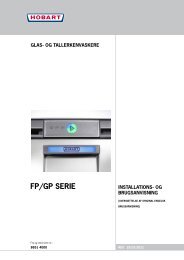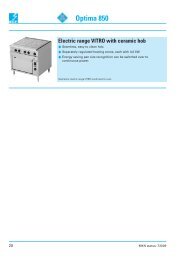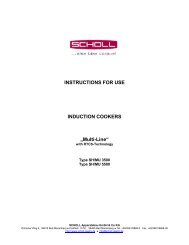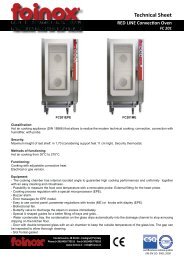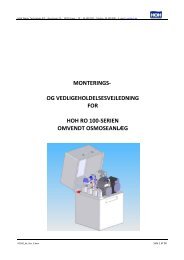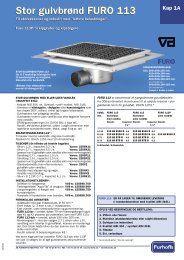E_CN_Druckboiler - Bent Brandt WebShop
E_CN_Druckboiler - Bent Brandt WebShop
E_CN_Druckboiler - Bent Brandt WebShop
You also want an ePaper? Increase the reach of your titles
YUMPU automatically turns print PDFs into web optimized ePapers that Google loves.
Warewasher<br />
<strong>CN</strong>B Series<br />
(with Standard-Control)<br />
INSTALLATION OPERATION<br />
VERSION 17.11.2004
2<br />
Important Notes<br />
Installation and Operation Instructions<br />
for Warewasher <strong>CN</strong>B Series<br />
Content Page<br />
1 Assembly .............................................................................................. 3<br />
2 Electrical connection ............................................................................. 5<br />
3 Water connection .................................................................................. 6<br />
4 Steam or high pressure hot water connection ...................................... 7<br />
5 Exhaust connection............................................................................... 7<br />
6 Dispensers ............................................................................................ 8<br />
7 First run ................................................................................................. 9<br />
8 Control Panel ...................................................................................... 11<br />
9 Preparation ......................................................................................... 14<br />
10 Operation ............................................................................................ 16<br />
11 Cleaning the machine ......................................................................... 16<br />
12 Position of curtains.............................................................................. 18<br />
13 Frost prevention .................................................................................. 19<br />
14 Maintenance ....................................................................................... 19<br />
15 Trouble shooting guide ........................................................................ 20<br />
Machine noise level is ≤ 70 dB (A)<br />
● Use in Accordance with Regulations<br />
This machine is exclusively to be used to wash ware such as plates,<br />
cups, glasses, cutlery, trays etc.<br />
Do not use for electrically heated cooking and heat conservation<br />
appliances.<br />
● Safety<br />
If a starch attack system is built in, the detergent company has to take<br />
care of all relevant safety rules and regulations.<br />
Please avoid any contact with the concentrated detergent.<br />
Never hose down the exterior of the machine.<br />
The "Attention" symbol is shown beside instructions that are essential<br />
for the safe operation of the machine. Please read these passages<br />
very thoroughly.<br />
● Liability<br />
Installations and repairs which are not carried out by authorized<br />
technicians or the use of other than original spare parts, and any<br />
technical alterations to the machine, may affect the warranty set<br />
out in the standard conditions of sale.<br />
● Important:<br />
This Instruction manual is written for machines with an operating direction<br />
from left to right. For machines with an operating direction of right to left,<br />
the same information applies but with opposite handling directions.
OK<br />
1<br />
?<br />
2<br />
OK<br />
?<br />
1<br />
2<br />
1 Assembly<br />
Should be carried out by authorized Service technicians.<br />
1.1 Transport to installation location<br />
– If possible in its packing and on skid.<br />
– Push on rollers.<br />
– Avoid damage to floor and doors.<br />
1.2 Remove packing<br />
– Cut steel bands.<br />
– Remove carton.<br />
– Remove wooden skid.<br />
– Remove inside packing material and accessories.<br />
1.3 Locating<br />
– According to installation plan.<br />
– Consider wall clearance (normally 39 mm).<br />
– Consider length of tabling, conveyors, etc.<br />
1.4 Adjusting machine height<br />
– Level machine to compensate floor unevenness.<br />
– Distribute machine weight equally onto all feet.<br />
1.5 Assembly of modules<br />
If the machine is delivered in separate modules.<br />
– Put largest module in place and level.<br />
3
4<br />
D<br />
A<br />
C<br />
E<br />
B<br />
1.5.1 Sealing Tape<br />
No. 168 834 must be stuck on one of the connecting surfaces.<br />
– If old tape (from factory testing) is still left, this must be removed<br />
previously.<br />
– The sealing tape must overlap at the corners.<br />
1.5.2 Add next module<br />
– Level height (see also 1.4).<br />
– Connect by using screws M6 x 12 hex. head, washers,<br />
lockwashers and nuts (supplied).<br />
– Cut protruding sealing tape with knife.<br />
– Connect drain pipes.<br />
1.5.3 Tank connections<br />
(Connect all washtanks with the overflow pipes.)<br />
– Set gasket (A) on the overflow pipe (B).<br />
– Put overflow pipe (B) from the inside of the tank through the<br />
prepunched hole and tighten it with the nut (C).<br />
– Push the hose (D) over the pipe (B) and fix them with a hose<br />
clamp (E). Connect them with the overflow pipe of the next tank.<br />
1.5.4 Transport feet (if exist)<br />
Must be removed and returned to HOBART.<br />
1.6 Electrical cables<br />
Must be unrolled and drawn through the cable channel.<br />
– Connect wires to the terminals of the electrical components.<br />
– Follow the wiring diagram and the labels on wires and<br />
terminals.
12<br />
1.7 Attach dish rack tables and accessories<br />
– See separate instructions.<br />
– Seal screw holes.<br />
– Allow a slight inclination to the machine (if needed, adjust level<br />
by turning the feet).<br />
– Pay attention, that the table-top corresponds with the table<br />
connection of the machine.<br />
(it means, the catches of the rack transportation must overtop<br />
the table level more than 12 mm)<br />
– Table end switch:<br />
Wiring to control box must be protected.<br />
– Tables on rollers including end switch:<br />
Close the connector of the cable and lock it.<br />
2 Electrical connection<br />
Must be carried out by a qualified technician according<br />
to the national and local codes.<br />
2.1 Check<br />
– Open the control box and take out wiring diagram from the<br />
inside of the door.<br />
– The electrical supply shall comply with the name-plate data and<br />
the wiring diagram.<br />
– Line fuses and cable cross section shall comply with the<br />
requirements.<br />
– Supply disconnecting device (main switch with emergency stop<br />
function) adjacent to the machine (if not built in).<br />
5
6<br />
OK<br />
?<br />
1<br />
2<br />
2.2 Connection<br />
– Draw cable (H07-RN-F) through cable gland at the bottom of<br />
the control box rear panel.<br />
– Connect wires to main terminals or to main switch (if built in).<br />
– Tighten all terminal screws in the control box (may be loosened<br />
during transport).<br />
– Tighten all cable glands.<br />
According to EN 60 335 the appliance must be connected to an<br />
equipotential conductor. The connecting screw ( ) is located at<br />
the rear of control box beside the cable inlet.<br />
3 Water connection<br />
Must be carried out by a qualified technician according<br />
to the national and local codes.<br />
The machine must be operated with water of drinking quality.<br />
For water with a high mineral content, water treatment is<br />
strongly recommended.<br />
3.1 General<br />
– Connect water supply and drain pipes according to installation<br />
plan.<br />
– Line strainer and class A air gap are fitted to the machine as<br />
standard.<br />
3.2 Freshwater supply for rinse (G 3/4")<br />
– Should be soft (up to 8° Clark, resp. 1.1 mmol/l).<br />
– Must be cold if condenser is fitted.<br />
– Line flow pressure 1.5 - 6 bar at ~ 500 l/hr.<br />
– Provide shut-off valve.<br />
3.3 Fresh water supply for fill (G 3/4" – Option)<br />
– Should be soft (up to 8° Clark, resp. 1.1 mmol/l) and<br />
warm (50 - 60°C).<br />
– Line flow pressure 1.5 - 6 bar.<br />
– Provide shut-off valve.<br />
3.4 Drain connection<br />
To be connected to site drain:<br />
– Common drain DN 50<br />
– Drip water drains of tabling, sink and other elements.<br />
– All drains must be connected to goose neck (individually or<br />
single point).
OK<br />
?<br />
1<br />
2<br />
4 Steam or high pressure hot water<br />
connection<br />
Must be carried out by a qualified technician according<br />
to the national and local codes.<br />
NOTE FOR INSTALLATION<br />
Make sure that pressure and temperature of the heating<br />
medium do not exceed values indicated on the installation plan.<br />
4.1 General<br />
– Connect supply and return pipes according to installation plan.<br />
– All connections are equipped with neccessary fittings and<br />
valves as standard.<br />
4.2 Connection<br />
Following units must be connected to supply and return pipes:<br />
– rinse booster heater<br />
– tank heating<br />
– dryer (if installed)<br />
4.3 Insulation<br />
– All pipes should be insulated.<br />
– Insulating material should be water, heat and shock proofed.<br />
5 Exhaust connection<br />
– Connection must be carried out in conjunction with competent<br />
ventilation engineer.<br />
– Please pay attention to notes on the service drawing.<br />
5.1 Exhaust into the kitchen<br />
(Only possible in connection with PROVENT-Heat Pump System<br />
and sufficient room ventilation.)<br />
– Avoid condensate damage by mixing exhausts from vent outlet<br />
of the machine, directly with room air (air distributor).<br />
7
8<br />
A<br />
10 cm<br />
5.2 Exhaust pipework<br />
– Leave a distance (approx. 10 cm) between machine exhaust<br />
and site channel or connect special extension hood (option).<br />
– Use additional ventilation fan, as the built-in ventilator has no<br />
compression.<br />
The volume of air to be evacuated from site has to be larger<br />
than the volume of air from the machine (see installation plan).<br />
– To prevent corrosion damage, provide exhaust channel in<br />
stainless steel or synthetic material.<br />
– In case of extremely low temperatures:<br />
provide insulation and anti-freeze shutter.<br />
6 Dispensers<br />
of detergent and rinse agent<br />
– Normally, dispensers and controls are delivered and installed<br />
by the detergent and rinse agent suppliers.<br />
– Install dispensers, controls and containers such that they are<br />
easy to handle and do not disturb machine operation.<br />
– Rinse agent connection (A) is provided above the rinse booster<br />
heater (R 1/8" inside).<br />
– Terminals (230V~) are provided in the control box<br />
(see wiring diagram).<br />
It is recommended that dispensers and their controls are<br />
not fitted directly to the machine!<br />
(Thermal insulation panels could be damaged.)<br />
The injection of detergent should be carried out at the tank<br />
side wall.<br />
Use only commercial detergent and rinse agent (suitable<br />
for professional and industrial operations).<br />
Please pay attention to the chemical suppliers safety<br />
instructions.
0<br />
°C<br />
7 First run<br />
Must be carried out to adjust and check machine functions.<br />
See also chapter 8 (Controls).<br />
Must be carried out by an authorized<br />
Service technician!<br />
7.1 Preparation<br />
– Switch off main switch.<br />
– Make sure, that detergent and rinse agent containers are filled.<br />
– Open water supply.<br />
– Open control box and switch on all circuit breakers and<br />
motor protection switches.<br />
Exception: if electrical rinse booster heater is installed:<br />
make sure that its sealed protection switch is switched off<br />
(see wiring diagram).<br />
– Close inspection doors.<br />
– Switch on main switch.<br />
7.2 Fill rinse booster heater and tank(s)<br />
– Press the contactor for the pressure pump of fresh water<br />
storage tank until water sprays out of the rinse jets.<br />
– Check if all rinse jets sprays correctly.<br />
If not: remove rinse arms and clean jets.<br />
– Switch off main switch.<br />
Electrically heated machine:<br />
– Remove the red sticker from the protection switch of rinse<br />
booster heater (A) and switch on protection switch (B).<br />
Steam- / high pressure hot water heated machine:<br />
– Open shut-off valves.<br />
– Close control box.<br />
– Switch on main switch and set ON / OFF-switch to "fill"<br />
position.<br />
– After reaching the correct water level, filling switches off automatically<br />
and the tank heating(s) switch(es) on.<br />
– When correct temperatures obtained (the green OK pilot light<br />
illuminates), the machine is ready for operation.<br />
7.3 Fresh water quantity<br />
The fresh water quantity is adjusted at the factory and may not be<br />
changed.<br />
If a new adjustment is needed, please call the after-sales service.<br />
9
10<br />
7.4 Check<br />
– Direction of rotation of motors (see direction sign):<br />
- Pumps<br />
- Conveyor motor<br />
- Exhaust fan<br />
- Dryer fan (if dryer is fitted)<br />
If motor runs against the indicated direction, interchange<br />
2 of 3 phases at the terminal.<br />
– Check and eliminate potential leakages on:<br />
- Drain<br />
- Heating pipework and water supply pipework<br />
- Machine housing, bottom of tanks, exhaust system<br />
7.5 Autotimer (Option)<br />
Wash, rinse and dryer (if fitted) operate only if racks are passing<br />
through the machine.<br />
These functions switch off automatically if no further racks follows.<br />
The delay times can be adjusted by authorized Service Technicians.<br />
7.6 Temperature adjustment<br />
Temperatures are pre-adjusted at the factory.<br />
If a new adjustment is needed, please call the after-sales service.<br />
7.7 Adjustment of detergent and rinse agent<br />
Should be done by the detergent and rinse agent supplier.<br />
7.8 Adjustment of Timer "fill"<br />
The timer is pre-adjusted at the factory.<br />
If a new adjustment is needed, please call the after-sales service.<br />
7.9 Adjustment of exhaust system<br />
Should be adjusted by a qualified Service technician.<br />
(Required exhaust volume at site is 1600 m3 /h.)<br />
If a new adjustment is needed, please call the after-sales service.
8 Control Panel<br />
5 6 7 9<br />
1 ON / OFF switch<br />
(illuminates during drain cycle)<br />
Switches the machine on or off.<br />
Starts the fill cycle (exhaust and heating will<br />
start automatically) or drain the tanks.<br />
2 Conveyor ON button<br />
Switches the conveyor of the machine on.<br />
The wash cycle will start automatically.<br />
3 Conveyor OFF button<br />
Switches the conveyor and wash off.<br />
1 3 2 4 8<br />
4 Conveyor speed selection switch (option)<br />
I = slow (according DIN 10 510)<br />
II = fast (nominal speed)<br />
5 OK pilot light (green)<br />
Indicates that the machine is ready for use.<br />
6 Temperature display – wash<br />
Indicates the current temperature of the last<br />
wash tank.<br />
7 Temperature display – rinse<br />
Indicates the current temperature of the final<br />
rinse water.<br />
O<br />
I<br />
10<br />
11<br />
ON - OFF<br />
8 Temperature display button<br />
By pushing this button the display indicates<br />
individual tank temperatures or dryer<br />
temperature (see chapter 8.1).<br />
9 Warning light (red)<br />
Indicates that a motor protection switch has<br />
cut out or one of the temperature probes is<br />
defective.<br />
The wash temperature display ➅ indicates the<br />
N o of the defect probe, the rinse temperature<br />
display ➆ indicates the failure.<br />
(e.g.: S = short circuit, L = open circuit)<br />
10 Main switch (option)<br />
Must be on position I during operation and on<br />
position 0 during repair and maintenance.<br />
11 Emergency Stop button (option)<br />
Switches the machine off.<br />
Must be unlocked for operation.<br />
11
12<br />
?<br />
°C °C<br />
°C °C<br />
°C °C<br />
°C °C<br />
°C °C<br />
°C °C<br />
°C °C<br />
8.1 Temperature display<br />
By pushing this button ➇, individual temperatures (such as<br />
pre-wash, wash, rinse or dryer) can be displayed.<br />
Press the temperature display button.<br />
Wash ➅ and rinse ➆ temperature display changes into the<br />
display mode. The wash temperature display ➅ indicates the<br />
selected measuring point, the rinse temperature display ➆<br />
indicates the current temperature.<br />
Measuring point 1<br />
Indicates the current prewash temperature<br />
(if a pre-wash tank is fitted).<br />
Measuring point 2<br />
Indicates the current temperature at wash tank 1.<br />
(Valid only for machines with more than one main wash tank.)<br />
Measuring point 3<br />
Indicates the current temperature at wash tank 2.<br />
(Valid only for machines with three main wash tanks.)<br />
Measuring point 4<br />
Indicates the current temperature of the last wash tank prior<br />
to the rinse.<br />
Measuring point 5<br />
Indicates the current final rinse temperature.<br />
Measuring point 6<br />
Indicates the current dryer temperature (if a dryer is fitted).<br />
By pushing the temperature display button again, the display<br />
changes back into the basic mode.<br />
(Current wash and rinse temperature display.)
°C<br />
°C °C<br />
°C °C<br />
8.2 Faults<br />
If a failure arises during operation, it will be indicated by the<br />
flashing of the red warning light.<br />
– The flashing of warning light without other information at the<br />
temperature displays (➅ and ➆), indicates a motor fault.<br />
– The flashing of warning light and a further indication appears<br />
at the temperature displays, it indicates a temperature probe<br />
fault (short circuit or open circuit).<br />
Example:<br />
The warning light flashes and the left temperature display ➅<br />
shows F 1, and the right display ➆ shows an S or L.<br />
This means:<br />
The temperature probe F 1 failed by a short circuit (S) or an open<br />
circuit (L).<br />
13
9 Preparation<br />
Place pump intake strainers in Put the flat strainers in place. Put the strainer basket in place.<br />
position at the bottom of wash tank.<br />
Put the rinse strainer in place. Set wash arms in place: Set rinse arms in place.<br />
Upper: set wash arm in side guides, Upper: set rinse arm in back opening,<br />
move to end position and drop-in move from below into guide and<br />
over stop unit. click into place.<br />
Lower: move wash arm in side Lower: move rinse arm in guides<br />
guides to end position and click<br />
into place.<br />
to end position and click into place.<br />
Put curtains in place Close inspection doors. Switch on main switch and turn<br />
(see page 18). Ensure sufficient detergent and the machine ON / OFF switch to<br />
rinse agent is available in the right "Fill" position<br />
containers. Fill, exhaust and heating elements<br />
Open shut-off valves. start automatically. Wait until the<br />
green OK pilot light illuminates.<br />
14<br />
0<br />
°C
9.1 Racking<br />
When loading plates<br />
consider the machine direction.<br />
Gastronorm pans and other large containers or boards should ideally<br />
be washed in a separate Utensil Washer.<br />
In a <strong>CN</strong> these items may cause problems such as splash-over leading<br />
to low water levels in the tank/s and poor rinsing.<br />
On the occasions when these items are to be washed, they should be<br />
loaded sloping towards the direction of machine operation as shown<br />
in the picture. This will reduce the problems described above.<br />
15
10 Operation (Remove coarse food soil before washing.)<br />
To start the conveyor, push the Push the Conveyor OFF button to Check temperatures from time to<br />
Conveyor ON button. stop the conveyor and also before time.<br />
Put the washware in suitable racks changing the conveyor speed. Give washware enough time to<br />
on conveyor. dry after washing.<br />
11 Cleaning the machine<br />
Push the Conveyor OFF button. Wait until the tanks are completely Take out an clean curtains.<br />
Conveyor and wash stop. drained.<br />
Turn the machine ON / OFF switch Turn the machine ON / OFF switch<br />
to "Drain" position to empty the to "0" position and switch off main<br />
machine. Exhaust and heating will switch!<br />
stop automatically. Open the inspection doors.<br />
Remove wash arms: Remove strainer baskets. Remove flat strainers.<br />
Upper: press latch, lift wash arm<br />
over stop unit and pull out.<br />
Lower: lift wash arm to pull out.<br />
Pull out end caps and clean wash<br />
arms accurately.<br />
16<br />
0<br />
°C ° °C °C °C<br />
°C<br />
?
Remove pump intake strainers. Remove rinse strainer. Remove rinse arms:<br />
Upper: pull spring towards front<br />
and remove rinse arm.<br />
Lower: lift rinse arm and pull out.<br />
Control nozzle openings and clean<br />
if necessary.<br />
Hose down and clean the interior CLEAN ONCE A MONTH:<br />
of the machine (particularly the Remove cover at the top of the Hose down condensers.<br />
bottom of wash and prewash tank) condensers and slide away the<br />
to avoid any waste remaining. exhaust housing.<br />
0<br />
Hose down and brush the strainers – do not knock them to remove food soil! They could be damaged.<br />
Never hose down the exterior of the machine.<br />
To clean the machine do not use any chloric, acidic or abrasive products or metallic brushs.<br />
°C<br />
0<br />
To empty the tanks switch on main Wait until the tanks are completely Switch off main switch and close<br />
switch and turn the machine ON / emptied, then: shut-off valves.<br />
OFF switch to "Drain" position. Set the machine ON / OFF switch Leave the inspection doors open<br />
The drain pipes will be emptied to "0" position. for ventilation.<br />
again.<br />
°C<br />
O<br />
I<br />
17
12 Position of curtains<br />
18<br />
The working direction as shown is left / right.<br />
On working direction right / left the position of curtains is reversed .<br />
429<br />
325 360-7<br />
655<br />
630<br />
1<br />
781 067-1<br />
Prewash modules<br />
1<br />
419<br />
325 360-6<br />
645<br />
660<br />
2<br />
781 033-1<br />
A AR<br />
E<br />
325 360-7<br />
655<br />
630<br />
292 3<br />
4<br />
781 284-1<br />
3 2 1 3 3 1 3 2 3<br />
C<br />
Wash modules Exit module<br />
without dryer<br />
1 3 2 3 1 3<br />
2<br />
L<br />
OK<br />
1<br />
?<br />
2<br />
ND<br />
495<br />
1<br />
1 3<br />
325 360-7<br />
655<br />
630<br />
4<br />
781 067-2<br />
S<br />
2 3
13 Frost prevention<br />
(where required)<br />
Must be carried out by an authorized<br />
Service technician!<br />
Drain machine (start drain cycle).<br />
Set main switch to "0".<br />
Switch off the protection switch of the electrical rinse booster<br />
heater!<br />
All tanks, water pipework and armatures must be totally drained.<br />
– Close shut-off valves at site.<br />
– Remove plug at the bottom of the break tank.<br />
– Remove plug at the bottom of the rinse booster heater.<br />
– Disconnect pipe after the non-return valve and let it drain.<br />
– Drain site water pipework.<br />
– Drain traps of drain system.<br />
– Steam or hot water heated machines: drain all heating coils<br />
and pipes.<br />
– The condenser if fitted, must be blown out with compressed air.<br />
– Reset for operation according to chapter 7.<br />
14 Maintenance<br />
For trouble free operation we recommend an inspection or<br />
maintenance contract by qualified Service technicians.<br />
19
15 Trouble shooting guide<br />
TYPE OF FAILURE POSSIBLE CAUSE REMEDY<br />
tank fill too slow line strainer of fill clogged clean line strainer<br />
solenoid valve defective call the after sales service<br />
insufficient supply pressure provide correct services<br />
tank not filled to correct level fill cycle too short call the after sales service<br />
steam escapes from loading exhaust extraction too low call the after sales service<br />
or exit section<br />
wrong position of curtains check curtains<br />
temperatures too low too much exhaust extraction call the after sales service<br />
heaters defective check heaters, steam or high pressure hot<br />
water supply systems and thermostats.<br />
Call the after sales service.<br />
washware soiled after strainers wrongly positioned check strainers<br />
dishwashing<br />
curtains not fitted or wrongly placed check curtains (see chapter 12)<br />
wash jets clogged clean the wash arms<br />
too low detergent concentration increase detergent dispensing<br />
too much foam use non-foaming detergent only<br />
excessive food debris entering machine check pre-scrapping procedure<br />
temperatures too low check heating system<br />
conveyor speed too high select lower speed<br />
streaks and spots on strainers wrongly positioned check strainers<br />
washware<br />
wash water splashes into rinse section check curtains (see chapter 12)<br />
rinse jets clogged clean rinse jets<br />
inadequate rinse agent dispensing get the dispenser adjusted<br />
too high mineral content of rinse water use of demineralized water recommended<br />
washware do not dry incorrect temperature or humidity<br />
of drying air<br />
check heater and blower of drying unit<br />
conveyor speed too high select lower speed<br />
washware still greasy increase detergent concentration<br />
drops on washware inadequate rinse agent concentration get concentration increased<br />
dishes tilt over water pressure from below too high replace reducer between lower wash arm<br />
and wash pipe<br />
upper wash arms clogged remove wash arms and clean<br />
items too light use cover on racks<br />
machine out of order, main switch switched off, power supply switch on main switch, re-start machine<br />
display switched off completely cut-off<br />
emergency switch cut-off, power supply switch on emergency switch, re-start<br />
completely cut-off machine<br />
power failure re-start machine, when power available<br />
again<br />
As continued product improvement is a policy of HOBART, specifications are subject to change without notice.<br />
Printed in Germany AG-21314-A-11-04-PC




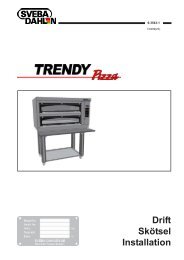

![PACOJET-DK[1]:Layout 1 - Bent Brandt WebShop](https://img.yumpu.com/18324212/1/184x260/pacojet-dk1layout-1-bent-brandt-webshop.jpg?quality=85)

